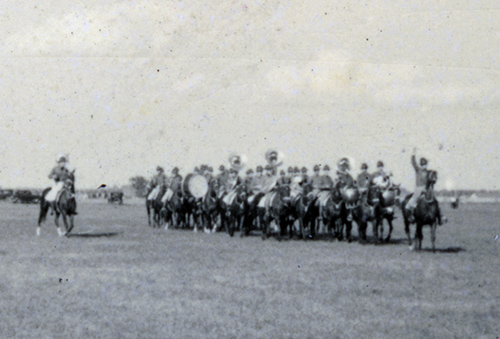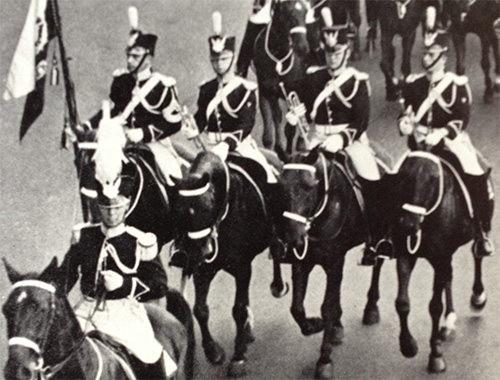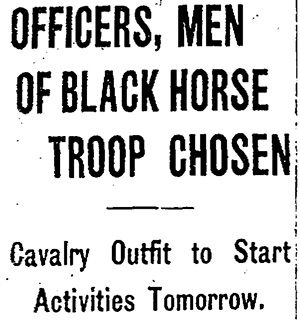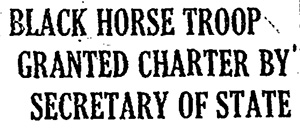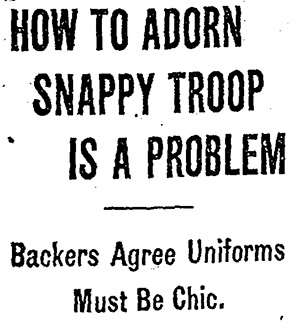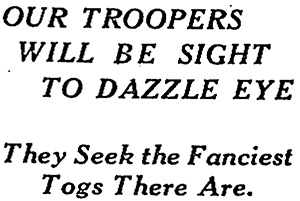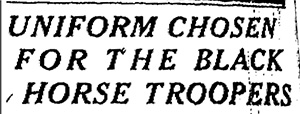December 13, 1929
GIVE CHAUNCEY M’CORMICK POST IN BLACK HORSE TROOP
Chauncey McCormick has been granted a captain’s commission in the Illinois National Guard by Gov. Emmerson and will be attached to Chicago’s Black Horse troop, according to word form Springfield last night.
Capt. McCormick, a Yale graduate, director of several large corporations and prominent clubman, had consented to direct the ceremonial of the Black Horse troop and undertake development of a polo team among the troopers, according to Leonard A. Busby, president of the association sponsoring the troop. Acpt. John T. Knight Jr. is the troop commander.
Mr. Busby, coincident with the announcement, said his committee expected to complete plans for financing the troop over a five year period by next Feb. 1.
May 20, 1930
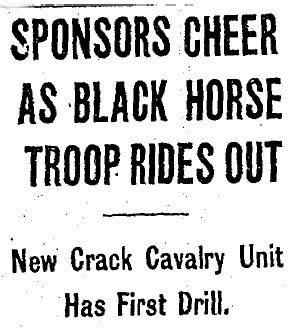
Chicago’s new Black Horse troop last night made its first public demonstration in a full dress drill, accompanied by its mounted band, in the arena of the Chicago Riding club, Erie street and McClurg court.
Society was there to view the new troop and 36 piece mounted band. The troop was organized by Chicago business men following the first announcement early in 1929 that a fund of $225,000 was sought to finance a Black Horse troop and bane, “to be made up of the finest young men in Chicago.” It was organized for the purpose of forming a crack troop to be used as a guard of honor when distinguished visitors came to Chicago.
Mustered Into State Service.
The troop was mustered into state service and federally accepted as Headquarters troop, 106th cavalry, Illinois National Guard on April 27, 1929. Later a committee headed by Mrs. Waller Borden chose a dress uniform for the troop. It is a dragoon uniform worn by troopers in 1812.
Preceded by the band, which also rode black horses, the troop entered the arena in single file to applause. Maneuvers continued for more than an hour. The troop is commanded by Capt. Chauncey McCormick.
High black patent leather boots, reaching above the knee in front; tight fitting breeches of white flannel; wide white leather belts; black blouses, also tight fitting, adorned with white fourragere, metal epaulets, white chevrons and silver piping on the collar, and white gloves constituted the uniform.
May 26, 1930
THE BLACK HORSE TROOP.
It was my pleasure on the evening of May 19 to witness the formal debut of the Chicago Black Horse troop, and, while the presentation was in a way spectacular, yet as an ex-cavalryman I was very much disappointed in the drill.
The troop as a whole appears to ride well, with the exception of mounting and dismounting, which was accomplished in many instances by the use of packing boxes, and in one case the assistance of two grooms was necessary to successfully dismount a trooper, much to the horror of one acquainted with cavalry monkey drill.
The manual of the saber appeared to include only drawing, carrying, presenting, and returning, the finer techniques of cuts, parries, moulinets, etc., being omitted – and one would not expect such omissions by a crack outfit on display. Perhaps they are not a finished product as yet, but then have they not been drilling for a year?
The uniform, while striking, is in some ways impractical. The shako has a coat button on either side instead of a shako button, causing great discomfort to the wearer, and the baldric, while ornamental, could have been put to use had it been attached to the belt, thus supporting the saber and thereby relieving the strain from the blouse.
The troop, in a street parade, will perform to the satisfaction of most Chicagoans, but they did not function the other evening as a crack organization, by comparison with the balance of the 106th cavalry regiment.
It is high time that the military of this country were elevated to a position that will command the respect of citizens, but if the military expects this respect, they must be so superbly drilled as to merit that honor.
EX-CAVALRYMAN.
March 30, 1931
Black Horse Troopers to Give Show on Friday
The Black Horse troop will hold drills and ceremonies at the Chicago Riding club next Friday evening before its sponsors and hundreds of cadets of the ROTC of Chicago high schools. The mounted drill will be directed by Capt. Chauncey McCormick, troop commander. He will be aided by Lieuts. Paul Butler, Roy D. Keehn Jr., and W.E. Myers. Mar. Gen. Frank Parker, commander of the Sixth corps area, will be the guest of honor.
April 4, 1931
Black Horse Troop Drills Before Crowd at the Riding Club
The Chicago Black Horse Troop and mounted band of the Thirty-third division performed last night at the Chicago Riding club, 330 East Ontario street, before more than 2,500 persons, including several hundred cadets from the R.O.T.C. unites in Chicago high schools.
One of the most difficult feats of the evening consisted of acrobatics on galloping horses. The troop also rode through arcs of fire, participating in jumping contests and in in the manual of the saber. A full dress review before Maj. Gen. Frank Parker, commander of the Sixth corps area, was a part of the program.
The troop was commanded by Capt. Chauncey McCormick.
January 23, 1932
WEST’S BEST POLO STARS WILL PLAY ON CHARITY CARD
Two of the outstanding polo players in the middle west will compete at the Chicago Riding club Feb. 12, in the matches for the benefit of the Joint Emergency Relief fund. The are Capt. Maxwell M. Corpening, the wet’s outstanding player with his six-goal rating, and Maj. CC Smith of Fort Sheridan, famous international star of the United States army, a five goal man.
The ten other men who will appear in the two games will be picked from nearly fifty players of the Chicago district who are working out nightly at the Chicago Riding club, the 124th Field Artillery armory, and other arenas. Among these are Frank Bering, Herbert J. Lorber, James A. Hannah, Prentice Porter, Capt. CA Wilkinson and Lieut. HD Reed of Fort Sheridan; Lieut. Paul Butler, Lieut. Col. RG Hunter, Lieut. CM Schuh, George Bates, Capt. W.S. Everett and Dave Silberman.
Lorber is chairman of the committee arranging the event. In addition to the polo matches there will be an exhibition drill by the famous Black Horse troop of the Illinois National Guard.
March 11, 1932
Oak Parker
Members of the Black Horse Troop Band will make their first public appearance under their own auspices Wednesday, March 16, at a benefit band concert to be held in their arena at the Chicago Riding club, East Ontario and McClurg Court, it was announced recently by Bandmaster A. Boyd Pixley of 236 South Cuyler avenue.
During the intermission, members of the troop will assist their musical brothers by furnishing further entertainment in the form of a polo game.
November 11, 1937
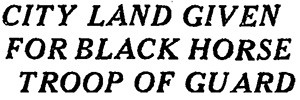
The city council yesterday donated to the Illinois National Guard a rectangular plot of land adjoining the 122d field artillery armory on Seneca street between Chicago avenue and Pearson street. On it will be erected a building to house troop B of the 10th cavalry, the famous Black Horse troop.
Maj. Gen. Roy D. Keehn, commander of the 33d division of the guard, said the addition will provide an arena convenient to the loop large enough for all military purposes, polo games and horse shows.
The land is estimated to be worth $500,000.
December 23, 1937
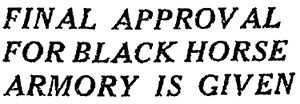
Final approval for a new armory for troop B of the Illinois National guard, the Black Horse troop, has been given by Gov. Henry Horner, it was revealed yesterday, and the Illinois Armory board, under Maj. Gen. Roy D. Keehn, will proceed at once with plans for financing its construction.
The armory, for which land valued at $500,000 was donated last month by the city council, will adjoin the 122d field artillery armory, 234 East Chicago avenue. It will be as large as any in the state, and will be used by the Black Horse troop and the 122nd regiment, as well as for civic and athletic events. It is believed the building will be finished by next fall.
September 9, 1938
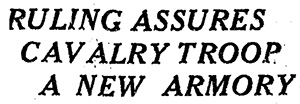
By a decision of the Illinois Supreme court yesterday in a test case, the Chicago Black Horse Troop and Mounted Band is now assured a modern armory. The suit was brought to test recent legislation empowering cities to donate land for armory purposes.
Mayor Kelly sponsored an ordinance directing the city to deed land west of the 122d field artillery for construction of an armory for the Black Horse troop. This will adjoin the existing building, extending west to Seneca street between Pearson street and Chicago avenue.
The enlarged arena will provide additional training features for the 122d field artillery. The new building also will include an officers’ club room and a memorial hall dedicated to founders of the troop.
January 12, 1940
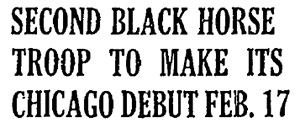
Chicago’s 2d Black Horse troop, which is being recruited by officers of the Illinois National Guard, will make its official debut Feb. 17 at the dedication of the new annex of the 122d Field Artillery armory on East Chicago avenue. Only 15 more recruits are needed to bring the troop to its full strength of 66 men, Lieut. William Kirby said yesterday.
The new troop is Black Horse troop F of the 106th cavalry regiment, formerly stationed at Springfield. On orders of the war department, the national guardsmen assignd to the troop were transferred to an armored car unit, and the troop’s horses were sent to Chicago.
Troop F shares quarters in the new annex with troop E, Chicago’s first Black Horse troop, commanded by Capt. Roy D. Keehn Jr.
February 18, 1940 [READ MORE ABOUT THE DONATION OF THE LAND FOR THE ARMORY ADDITION, HERE.]
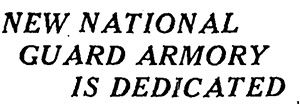
The new National Guard armory at Chicago avenue and Seneca street, which will be occupied by the 122d field artillery regiment and the Black Horse squadron, was formally dedicated last night and turned over to the state by the Illinois armory board.
November 24, 1940
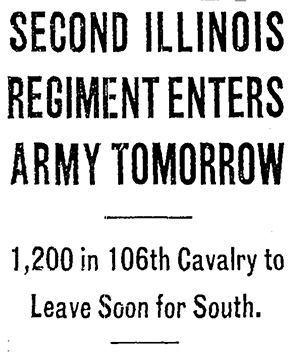
The motorized 106th cavalry regiment, consisting of 1,200 Illinois National Guardsmen from Chicago, Springfield, and Urbana, will be mobilized tomorrow for a year of training under the national defense program. Troopers in the regiment weill remain at their local armories for about 10 days before they leave for Camp Livingston near Alexandria, La., where they will be stationed.
The 106th is the second Illinois National Guard unit mustered into federal service.
Mounted troops will assemble tomorrow in the armory at 234 East Chicago avenue.
Included among the 400 horse mounted troopers is Chicago’s famous Black Horse squadron commanded by Maj. Roy D. Keehn Jr.
At the time the troop was organized with the authority of the war department 100 black horses were needed while federal National Guard funds were provided. Money was needed also to buy uniforms patterned after those of the United States dragoons of the war of 1812 who had been stationed at Fort Dearborn.
To supply the necessary funds Chicago citizens dug into their pockets and contributed $100,000, plus $9,000 more annually for expenses. Since the depression the troop has helped support itself by conducting military exhibitions and polo games.
Officers of the troop see the mobilization order as the end of their colorful organization. They say it is doubtful whether they can get enough black horses to fill its needs.
From the 2nd week of November 1940 through 1942 newspapers reported on the Black Horse Troop's mobilization and being mustered into federal service to serve in the Second World War. The Troop was mechanized - similar to the plight of the original First Cavalry at the onset of the First World War - and it never recovered its status as a ceremonial horse troop.
After WWII, former Black Horse Troop members formed an American Legion post and in ten years the Troop, diminished for lack of membership, dissolved. In the mid-1980s, another incarnation of the Black Horse Troop Association appeared in the Chicago area and appeared in suburban parades.
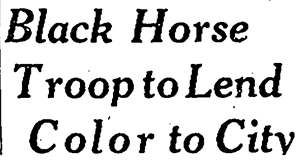
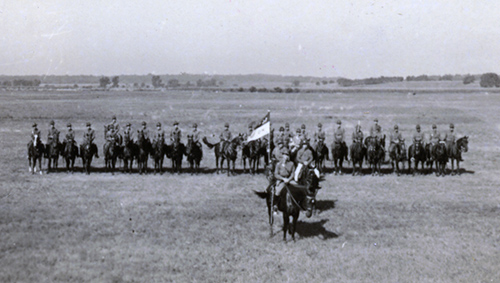
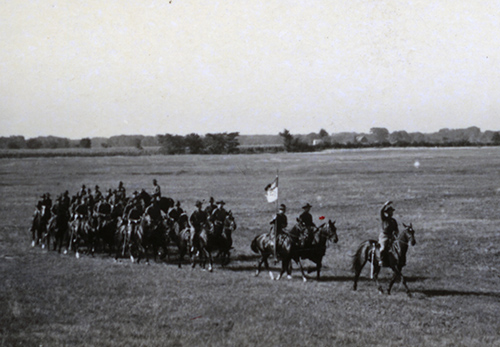
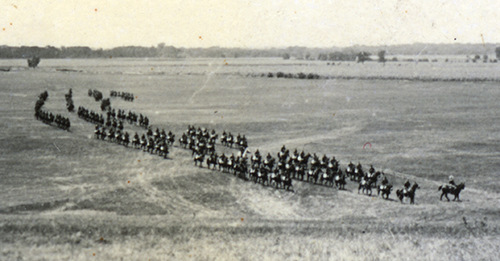
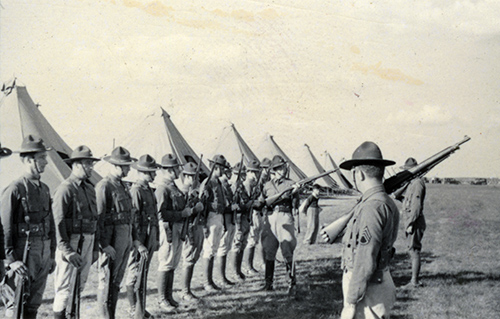
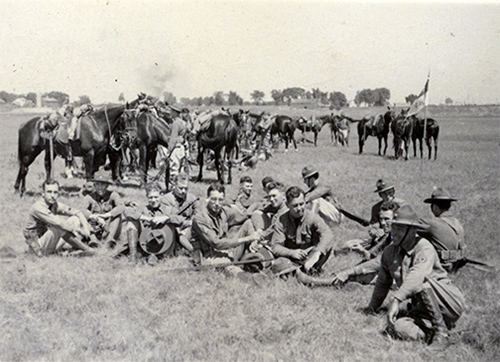
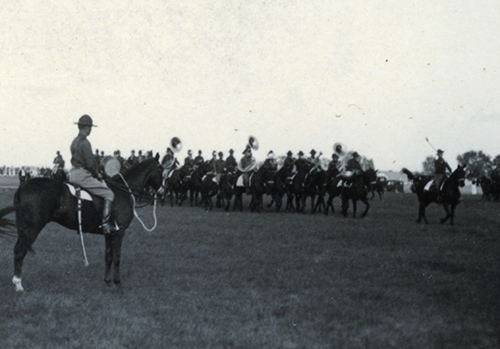
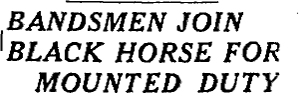 (Excerpts)
(Excerpts)
